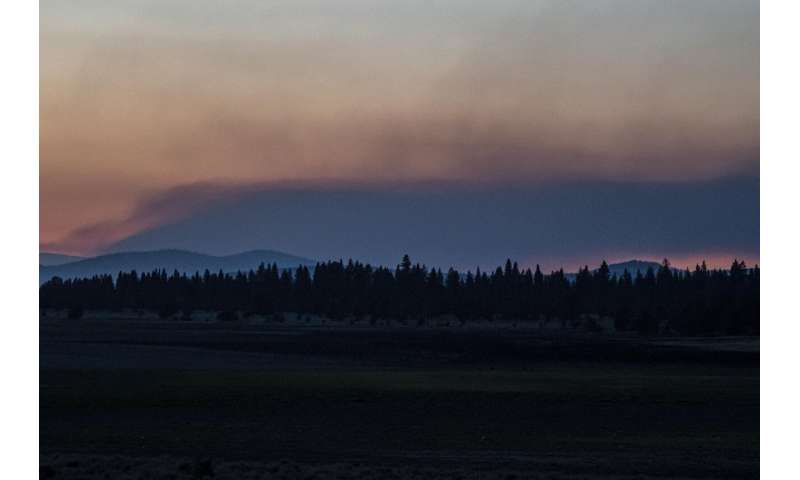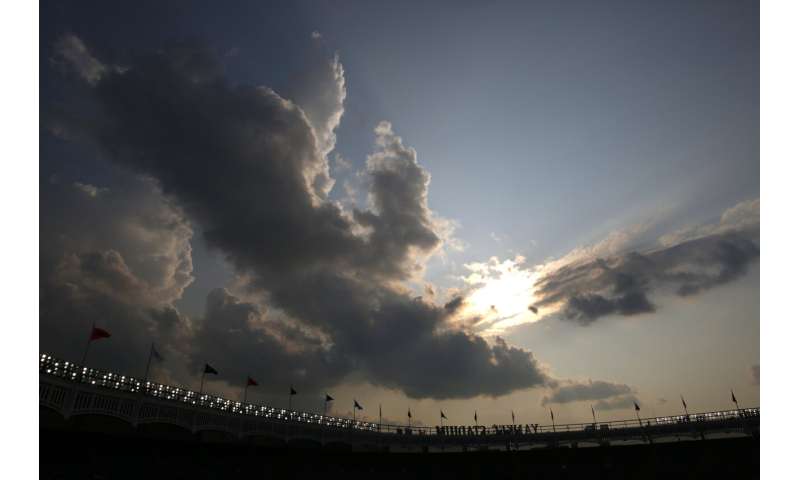Western wildfires grow, but better weather helps crews

Lower winds and better weather helped crews using bulldozers and helicopters battling the nation's largest wildfire in southern Oregon, but gusty winds pushed a Northern California wildfire into Nevada on Thursday, prompting evacuations as blazes burn across the West.
Oregon's Bootleg Fire grew to 624 square miles (1,616 square kilometers)—over half the size of Rhode Island. However, authorities said higher humidity Wednesday and overnight and better conditions allowed crews to improve fire lines. The fire also was approaching an area burned by a previous fire on its active southeastern flank, raising hopes that a lack of fuel could reduce its spread, and the forecast was for favorable firefighting weather again Thursday.
"Fire crews and support personnel have made significant progress in containing this fire in the last few days," Joe Prummer, incident commander trainee of Pacific Northwest Incident Management Team 2, said in a statement. "However, we still have a long road ahead of us to ensure the safety of the surrounding communities."
The Oregon fire, which was sparked by lightning, has ravaged the sparsely populated southern part of the state and had been expanding by up to 4 miles (6 kilometers) a day, pushed by strong winds and critically dry weather.
The blaze, which is being fought by more than 2,200 people, is now more than one-third contained.

On Thursday, authorities said at least nine people working the fire had tested positive for COVID-19.
The Oregon Department of Forestry said people who test positive are quarantined away from the main fire camp. Also, people who report symptoms and anyone who worked closely with them are tested and isolated until results are returned.
At least 2,000 homes were ordered evacuated at some point during the fire, and an additional 5,000 homes were threatened. At least 70 homes and more than 100 outbuildings have burned, but no one is known to have died.
Meanwhile the Tamarack Fire south of Lake Tahoe had burned more than 78 square miles (202 square kilometers) of timber and head-high chaparral in national forest land. It erupted July 4 and was one of nearly two dozen blazes sparked by lightning strikes.

Windy conditions were hampering more than 1,200 firefighters Thursday battling the Alpine County blaze. It has destroyed at least 10 buildings, forced evacuations in several communities and had closed parts of U.S. 395 in Nevada and California.
Bill Beidler, an evacuee from Woodfords, California, said: "We've been suppressing fires for so many generations, when we get one, this is what we get. Everything burns. People are losing their homes and everything."
Blowing embers from flames ignited a new spot fire Thursday afternoon that jumped the highway north of Topaz Lake on the California-Nevada line, prompting an evacuation order at Topaz Lake Estates and neighboring areas.
Fire officials reported later Thursday the spot fire that started east of the highway in winds gusting to 25 mph (40 kph) was "growing rapidly despite firefighters' diligent efforts to contain it."
-

A couple walks along the beach in Cherry Grove, S.C., early Thursday, July 22, 2021. Smoke from wildfires in the western U.S. and Canada is blanketing much of the continent, including thousands of miles away on the East Coast. And experts say the phenomenon is becoming more common as human-caused global warming stokes bigger and more intense blazes. Credit: Mark Rogers/The Sanford Herald via AP -

A couple walks along the beach in Cherry Grove, S.C., early Thursday, July 22, 2021. Smoke from wildfires in the western U.S. and Canada is blanketing much of the continent, including thousands of miles away on the East Coast. And experts say the phenomenon is becoming more common as human-caused global warming stokes bigger and more intense blazes. Credit: Mark Rogers/The Sanford Herald via AP -

This satellite image provided by Satellite image ©2021 Maxar Technologies the Bootleg Fire in Oregon on Wednesday, July 21, 2021. The Oregon fire, which was sparked by lightning, has ravaged the sparsely populated southern part of the state and had been expanding by up to 4 miles (6 kilometers) a day, pushed by strong winds and critically dry weather that turned trees and undergrowth into a tinderbox. Credit: Satellite image ©2021 Maxar Technologies via AP -

Melted metal is seen near a home destroyed by the Bootleg Fire on Wednesday, July 21, 2021 near Bly, Ore. Credit: AP Photo/Nathan Howard -

A firetruck responding to the Bootleg Fire is driven past a hand-painted sign thanking firefighters on Wednesday, July 21, 2021 in Bly, Ore. Credit: AP Photo/Nathan Howard -

A damaged and abandoned excavator is seen in an area burned by the Bootleg Fire on Wednesday, July 21, 2021 in Bly, Ore. Credit: AP Photo/Nathan Howard -

Smoke rises from the Bootleg Fire on Wednesday, July 21, 2021 near Bly, Ore. Credit: AP Photo/Nathan Howard -

A fire-damaged sign hangs near trees burned by the Bootleg Fire on Wednesday, July 21, 2021 in Bly, Ore. Credit: AP Photo/Nathan Howard -

A fire-damaged mile marker sign hangs near trees burned by the Bootleg Fire on Wednesday, July 21, 2021 in Bly, Ore. Credit: AP Photo/Nathan Howard -

A home destroyed by the Bootleg Fire is seen here on Wednesday, July 21, 2021 near Bly, Ore. Credit: AP Photo/Nathan Howard -

A burned car damaged by the Bootleg Fire is seen here along a mountain road on Wednesday, July 21, 2021 near Bly, Ore. Credit: AP Photo/Nathan Howard -

A clearing sky appears over Yankee Stadium after a rain storm moved through clearing a haze of smoke before a baseball game between the Philadelphia Phillies and the New York Yankees, Wednesday, July 21, 2021, in New York. Wildfires in the American West, including one burning in Oregon that's currently the largest in the U.S., are creating hazy skies as far away as New York as the massive infernos spew smoke and ash into the air in columns up to six miles high. Credit: AP Photo/Adam Hunger -

Manhattan is seen from Yankee Stadium through a haze of smoke before a baseball game between the Philadelphia Phillies and the New York Yankees, Wednesday, July 21, 2021, in New York. Wildfires in the American West, including one burning in Oregon that's currently the largest in the U.S., are creating hazy skies as far away as New York as the massive infernos spew smoke and ash into the air in columns up to six miles high. Credit: AP Photo/Adam Hunger
"Firefighters on the ground and aircraft continue to battle the growing spot under exceptionally difficult weather and fuel condition," the Humboldt-Toiyabe National Forest said in an update.
It estimated the new blaze already had burned nearly 4 square miles (10 square kilometers). There were no immediate reports there of any injuries or structures destroyed.
To the northwest, the summer fun of boating and bathing came to an abrupt end for vacationers at Lake Almanor as the Dixie Fire spread up the west flank of the Sierra Nevada, expanding to more than 162 square miles. The west shore of the resort lake and many other small communities were under evacuation orders.
Meanwhile, Oregon on Wednesday banned all campfires on state-managed lands and in state campgrounds east of Interstate 5, the major highway that is commonly considered the dividing line between the wet western part of the state and the dry eastern half.
Extremely dry conditions and recent heat waves tied to climate change have made wildfires harder to fight. Climate change has made the West much warmer and drier in the past 30 years and will continue to make weather more extreme and wildfires more frequent and destructive.
© 2021 The Associated Press. All rights reserved. This material may not be published, broadcast, rewritten or redistributed without permission.




















